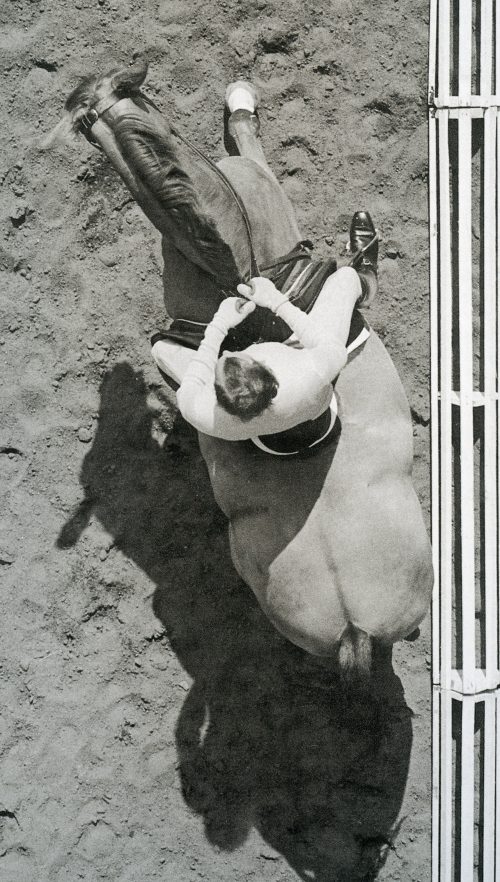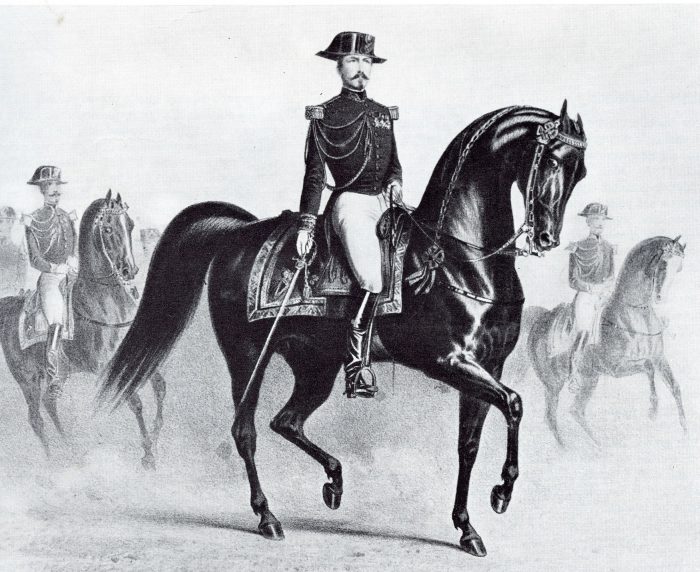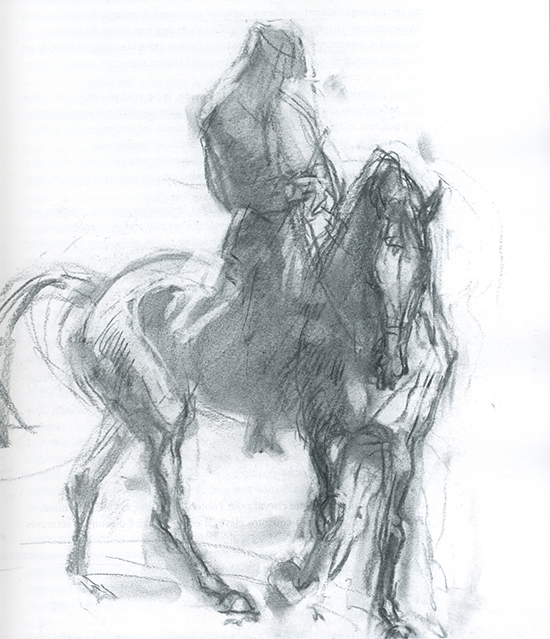with Henri van Schaik
There is no movement in dressage more controversial than the Shoulder-In.
All agree that it is a vital part of any horse’s training – but there are few who will agree as to how it should look, and how it should be executed.
Henri van Schaik, an internationally recognized dressage expert, looks at the FEI definition of the shoulder-in, and traces it to its origins to those two great masters – The Duke of Newcastle and François Robichon de la Guérinière…

In 1983 the FEI decided that the Shoulder-in should be executed on three tracks. The way Article 411,7,2 is written proves that the author took la Guérinière’s text as his guidance, because the wording reads:
“…The horse’s inside foreleg passes and crosses in front of the outside leg; the inside hind leg is placed in front of the outside leg… ”
Notwithstanding this, there are still a lot of people who are unhappy with this FEI decision and keep writing articles trying to prove that the FEI is wrong; they want the inner hindleg to step over the outside one.
One such article is entitled – ‘The Shoulder-in Betrayed’. I think it might be a good idea to go back to the source and find out what la Guérinière really said.
In 1733, François Robichon de la Guérinière published a book called ‘Ecole de Cavalerie’. Unfortunately a genius on horseback is not necessarily a master of language (although he is easier to read than any of his predecessors). La Guérinière contradicts himself, causing Parocel, his illustrator, to draw wrong diagrams.
As an explanation, I quote Gustave le Bon, a French psychologist, who wrote in his book ‘L’Equitation Actuell et ses Principes’ (1913):
“The fact that the riding masters find difficulties to formulate their methods and contradict themselves can often be explained by the fact that when they ride, they use unconsciously their nervous system, and when they write, they use it consciously.”
To understand the aim of la Guérinière when he conceived the idea of shoulder-in, one should read very carefully what he said in explaining how the concept of this movement developed.
In the beginning of the chapter on shoulder-in, he states that trotting on the straight line results in only limited suppleness, as it helps the forward movement of the shoulders and legs. The difficulties start when we try to supple the horse so that he can make circles and sideways (lateral) movements.

The Duke of Newcastle wrote endlessly about this problem; he thought that he could solve it by having the horse on the circle with the head in (la tête dans la volte). After four chapters about this subject, he writes: ‘….this is the end of my lessons to loosen a horse’s shoulders: if you are able to bring these lessons into practice, you can rest assured that you have achieved more than half in schooling a horse.”
This was in Chapter XXXI, then in Chapter XLIV, Newcastle comes to the following conclusion: “It is also very true that this (pushing the hindquarters out in the circle) does not put the horse on the haunches, but very much on the shoulders (because this lesson is not meant to put the horse on the haunches; the purpose is to loosen the shoulders).”
When he made use of this quotation, la Guérinière dropped the words between the brackets, very likely because he knew that no horse can loosen the shoulders when it is on the forehand. In the same Chapter XLIV, Newcastle writes:” …you should press with your inside leg, in order to get the horse’s inner hindleg close to the outside hindleg; because of the fact that the hindlegs come under the load and one leg being close to the other it is easy for the horse to keep the hindquarters engaged. NOBODY UNTIL NOW HAS DISCOVERED THIS TRUTH.”
All these quotations of the Duke of Newcastle will lead the reader to understand the influence Newcastle had on la Guérinière in his search to find a way to loosen the horse’s shoulders. Presumably la Guérinière used Newcastle’s book ‘La Nouvelle Methode’. This book was originally written in English in 1667 and in 1677 was translated by de Sollysel into French. The edition of 1700 was used for the direct quotations in this article.
The two main observations made by Newcastle that guided la Guérinière to the invention of the Shoulder-in are that on the circle, the horse comes on the forehand and that the hindlegs close together engages the hindquarters. In the quotation that follows, it is evident that la Guérinière has done some doctoring in the original Newcastle text.
“…the head-in, the haunches out, on the circle brings the horse on the forehand… (The shoulder cannot become supple) if the inner hindleg does not come close to and in front of the outer hindleg.”
La Guérinière goes on: “This admission, which experience confirms, makes it very clear that the circle is not the true means to supple the shoulders… a profound truth that this illustrious author (Newcastle) admits is that (the shoulders can only be suppled when the inner hindleg comes close to and in front of the outer hindleg); it is this judicious remark that has put me on the way to find the exercise: shoulder-in.”
La Guérinière must have been a very modest man; all the words between the brackets have never been written by Newcastle; and the rest appear in a chapter that deals with the engagement of the hindquarters. As far as the loosening of the shoulders is concerned, Newcastle stuck to the end to the circle. Thus it was the discovery of Newcastle that spawned the invention of la Guérinière! It is because of this modesty that Gustav Steinbrecht suggests that Newcastle was the real inventor of Shoulder-in.
The discovery of Newcastle that the inner hindleg has to come close to the outer hindleg is of course very important. Because of the fact that at one time la Guérinière prescribes that the hind legs step over, which has been reinforced by the illustration (looking at pictures is easier than reading), riders got in the habit of performing shoulder-in on four tracks.
Until 1983 the rules were not very clear and shoulder-in became head-in. It was unfortunate that in 1975 shoulder-in became a test movement, together with leg-yielding. The result of all this was that the concept of what the purpose of these two movements really was – got lost. Many riders gave their fantasy free rein, creating deviations, in which both leg-yielding and shoulder-in lost their identity.
One example is the counter shoulder in; Steinbrecht started this. In the very beginning of the Chapter on Renvers, la Guérinière warns against bringing the head of the horse at the wall; because of the support of the wall, the horse will do the movement by routine… and then when the horse is asked to do the same movement on the centre line, he is lost. La Broue also rejects this practice.
Another example is shoulder-in on the circle. The characteristic of shoulder-in is that in this movement the horse is NOT looking where he is going, therefore it is for me utter nonsense; it is a non-movement.
Evidently these riders got mixed up with the movement ‘the two ends in’ (in French ‘les deux bouts en dedans). This is an exercise to prepare a horse for the turn on the haunches and for the pirouette.
The purpose of leg yielding, always on the circle, is to loosen the hindquarters; the purpose of shoulder-in is to loosen the shoulders. The shoulders cannot be loosened if there is no engagement, if the forehand has not become lighter.
Both Newcastle and la Guérinière agree that the horse should, when he moves, be narrow behind. They both use the terms ‘étréci’.The purpose of both movements was schooling, not creating elegant movements.

When the inner hind leg steps over the outer hind leg, the horse widens behind, both authors use the Old-French expression ‘entablé’ to describe this. When a horse in the shoulder-in steps over the outside hind leg, it is not shoulder-in any more, but leg yielding. Because there is no push there is no more engagement, the horse loses the regularity in the movement and can damage the leg, as was explained by Louis Seeger, Gustav Steinbrecht and Waldemar Seunig.
Since nowadays practically everybody puts bandages on his horse, the danger of damage has been considerably diminished, but during the test no bandages are permitted.
In this day and age, when one thinks of power, one thinks of a motor. Therefore it is understandable that many authors compare the hindquarters of the horse with a motor. I have no problems with this. One has to understand however, that this motor can only function properly if it is in keeping with what Newcastle discovered, namely that the inner hind leg has to come close to the outside hind leg. If this is not the case, for example, when the inner hind leg steps over the outside hind leg, then, to stay with the metaphor of the motor, the movement is irregular; just as a four cylinder motor, that runs on only three cylinders.

L’Hotte – quiet, forward, straight…
When Steinbrecht said: “Ride your horse forward and make it go straight” and l’Hotte: “quiet, forward, straight’; this can only be achieved by horses who can push, because they are moving while narrow behind.
I want to end with one more quotation from Chapter XL V of La Nouvelle Methode: “In the preceding pages I have given you many reasons why we have to work hard to get a horse on the hindquarters, but there is still another reason I have to tell you about, which makes a lot of sense. The hindquarters of a horse carry nothing else but the tail, something that does not weigh very much; but the front legs have to carry the head, the neck and the shoulders, all together a lot heavier; and that neck, that head and those shoulders are always carried by those legs, as well when the horse works as when he rests: that is the reason why we put him on the haunches, to change the balance, taking weight off the front part, the weakest part and this is the only way to make a horse light in the hand, longer lasting and more pleasant to work with.”

